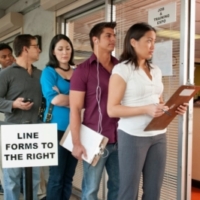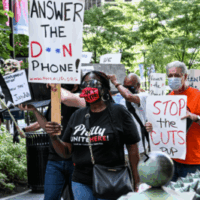Providing UI to Striking Workers Aligns with Purpose of Program
Unemployment insurance (UI) provides critical support to workers, their families, and state and local economies. Created in 1935 in the wake of the Great Depression, UI was created to protect workers and their families against unexpected drops in income, to support the overall economy during economic downturns by sustaining consumer demand, and to ensure workers do not have to accept a position that is far inferior to their old job, protecting against widespread wage suppression.
Providing UI to striking workers aligns with these purposes. A worker who goes out on strike after their union votes for it faces an uncertain economic future. Without a steady paycheck, workers miss rent payments, lose their healthcare, and cannot afford necessities like groceries and childcare. Providing these workers with limited economic support through the state UI system (on average, 33% of their prior wages) ensures they can continue to afford necessities and spend in their local economies.
Many workers temporarily disconnected from their employer like striking workers are supported by the UI system, such as seasonal workers, those on temporary layoffs, or those participating in the state work sharing program. Striking workers and their families should be entitled to the same economic support and should not be forced into poverty and desperation when exercising their protected rights.
California’s UI Trust Fund has Been in Crises for Decades
Expanding UI to striking workers whose employers have been paying into the UI trust fund on their behalf will not change California’s longstanding UI trust fund crisis. The number of potentially eligible striking workers simply pales in comparison to the overall pool of UI claimants, including the 157,000 workers who are, on average, laid off each month.[i] For context, in 2022, California paid out nearly $5 billion in regular state UI benefits to 890,000 workers.[ii] While it is difficult to estimate the number of striking workers that could possibly be eligible for UI in any year (on strike for more than 2 weeks and meeting all other UI eligibility requirements), data from the Bureau of Labor Statistics that collects data on strikes involving more than 1,000 workers indicates that large, long lasting strikes are rare and the number of striking workers simply does not compare to other eligible UI claimants across the state.[iii] It is also highly unlikely that all eligible striking workers would receive UI. In 2022, only 43% of California’s unemployed workers received UI.[iv]
As UI is “experience rated,” striking workers claims could impact their employer’s state UI tax rate but would not impact the rates of other employers. “Experience rated” means that CA employers state UI tax rate is based on the share of their former workers who receive UI benefits over a given period. The intent behind experience rating is to ensure that employers who lay off or otherwise discharge more workers bear more of the costs of paying for the UI system.[v] So, striking workers who successfully claim benefits would be included in their employer’s experience rating for that year. But those claims would not impact the experience rating and related tax rate of any other employer.
In contrast, California employers are facing higher federal UI taxes as California has failed to modernize its UI funding structure since 1983, so it entered the pandemic, like every other recent recession, with few reserves and falling well below the U.S. Department of Labor’s (US DOL) recommended solvency level. According to US DOL, besides the U.S. Virgin Islands, California’s trust fund was the least adequately funded of all 53UI programs heading into the pandemic.[vi] In fact, California has not met the US DOL’s recommended solvency level since 1990.[vii] This is because California remains one of only 4 states (alongside AR, FL, and TN) that has refused to expand its taxable wage base beyond the federally required minimum of $7,000. This regressive and fiscally irresponsible funding structure all but ensures the system will go insolvent during an economic downturn.
California could easily address the UI trust fund crises by expanding the UI taxable wage base and lowering the tax rate for low-wage sector employers. This would mean employers of high-wage workers would pay more into the system, which would help offset the higher benefits their workers are paid if they get laid off and employers of low-wage workers would pay less. Yet, this modernization has been opposed by many employer-backed interest groups and no reform has taken place since 1983. As a result, California’s trust fund is insufficient to cover benefit payments during economic downturns and must borrow from the federal government, meaning employer’s federal taxes go up and the state is on the hook for large interest payments.
Understanding the Benefit-Cost Ratio Add-On Waiver
Providing UI to striking workers is unlikely to impact California’s ability to get a Benefit-Cost Ratio (BCR) add-on waiver as California must address its UI trust fund crises over the next 5 years, which is when the BCR would potentially take effect.
Under federal law, after two years of outstanding federal loans, employers’ federal UI tax rates increase each year (through federal tax credit reductions) until the federal loan is repaid. Generally, employers experience a .3 percentage point increase in their federal tax rate. However, in the third year of unpaid loans, a 2.7 add-on rate is applied that uses a statutory formula that takes into consideration the average annual wages and the average employment contribution rate to determine at what rate employer taxes go up. Similarly, in the fifth year, that rate is potentially replaced by a “Benefit-Cost Ratio (BCR) add-on” that considers the state UI tax efforts in comparison to the average benefit payout over a five-year period to determine the rate of tax increase.[viii]
A state may avoid the BCR add-on and instead continue to use the 2.7 add-on if “the State has taken no action, effective during the 12-month period ending on September 30 of the year for which the waiver and substitution are requested, which has resulted or will result in a net decrease in the Solvency of the State unemployment compensation system . . ..”[ix] Not only is it unclear how an action taken in 2023 would impact the net solvency of the UI trust fund in 2027, but any assumption that it could presupposes that California is not going to take any action to address the UI trust fund crisis in the next 4 years, which is not a viable option. California must modernize and reform its UI tax structure to protect employers from increased federal taxes after every recession, taxpayers from having to cover the cost of ongoing interest payments, and employees from having to live on meager benefit amounts that have not changed since 2005—all things that are certain if California continues to ignore the longstanding underfunding of the UI system.
Providing UI for Striking Workers Is Consistent with Federal Law
UI is a joint federal-state program based upon federal law but administered by states under state law. Federal law establishes basic requirements, but each state has broad discretion to design its own program, including who is eligible for benefits.
If a state fails to comply with federal law, the US DOL, who oversees the UI program, can cut-off federal funding for UI administration and employers in that state could lose their federal tax credit. However, in the nearly 90 years of the program, the US DOL has never done this and is not likely to ever do so as it would effectively shut down a state’s entire UI system.
Nonetheless, providing UI to striking workers does not create a compliance issue that would even threaten US DOL action. New York has provided UI to striking workers since the beginning of its program, which existed even prior to 1935 when the federal program was established. When its law was challenged, the Supreme Court made clear that states have the right to decide if they want to provide UI to striking workers.[x] Furthermore, as striking workers would have to meet the same ongoing eligibility requirements as all other workers receiving UI, including that they are able, available, and actively searching for work, there is no federal conformity issue.
Endnotes
[i] U.S. Bureau of Labor Statistics, https://www.bls.gov/regions/west/news-release/jobopeningslaborturnover_california.htm.
[ii] U.S. Department of Labor, Unemployment Insurance Data, Benefits Paid Reports, https://oui.doleta.gov/unemploy/data_summary/DataSummTable.asp.
[iv] U.S. Department of Labor, Unemployment Insurance Chartbook, “Recipiency Rates, by State,” https://oui.doleta.gov/unemploy/chartbook.asp.
[v] To learn more about the UI tax structure and financing, please see the National Employment Law Project’s “Financing and Solvency Basics” policy advocacy brief, October 2022, https://www.nelp.org/publication/financing-and-solvency-basics/.
[vi]U.S. Department of Labor, “State Unemployment Insurance Trust Fund Solvency Report 2020,” https://oui.doleta.gov/unemploy/docs/trustFundSolvReport2020.pdf.
[vii] U.S. Department of Labor, “State Unemployment Insurance Trust Fund Solvency Report 2023,” https://oui.doleta.gov/unemploy/docs/trustFundSolvReport2023.pdf.
[viii] Congressional Research Service, “The Unemployment Trust Fund (UTF): State Insolvency and Federal Loans to States,” January 2023, https://crsreports.congress.gov/product/pdf/RS/RS22954.
[ix] 20 C.F.R. § 606.25
[x] New York Telephone Co. v. New York State Dept. Of Labor, 440 U.S. 519 (1979) ( “The omission of any direction concerning payment of unemployment compensation to strikers in either the NLRA or SSA implies that Congress intended that the States be free to authorize, or to prohibit, such payments, an intention confirmed by frequent discussions in Congress subsequent to 1935 (when both of those Acts were passed) wherein the question of payments to strikers was raised but no prohibition against payments was ever imposed.”).
Related to
Related Resources
All resourcesCase Study: How Virginia Worker Advocates Advanced Unemployment Insurance Reform in a Divided State Government

Policy & Data Brief
Letter on Making Reforms to Virginia’s Unemployment Insurance System

Comments & Letters
Letter on Rescinding Funds for Improving Unemployment Insurance Systems

Comments & Letters

